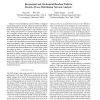162 search results - page 27 / 33 » Hierarchical Placement and Network Design Problems |
ASPDAC
2009
ACM
14 years 2 months ago
2009
ACM
— Power distribution networks (PDNs) are designed and analyzed iteratively. Random walk is among the most efficient methods for PDN analysis. We develop in this paper an increme...
CN
2007
13 years 7 months ago
2007
Although the ant metaphor has been successfully applied to routing of data packets both in wireless and fixed networks, little is known yet about its appropriateness for search i...
EMSOFT
2004
Springer
14 years 1 months ago
2004
Springer
As the bandwidth of CPUs and networks continues to grow, it becomes more attractive, for efficiency reasons, to share such resources among several applications with the minimum le...
CLUSTER
2000
IEEE
14 years 1 days ago
2000
IEEE
To construct a large commodity clustec a hierarchical network is generally adopted for connecting the host muchines, where a Gigabit backbone switch connects a few commodity switc...
ISCC
2006
IEEE
14 years 1 months ago
2006
IEEE
Most research on Distributed Hash Tables (DHTs) assumes ephemeral, lightly loaded deployments. Each node has a lifetime of a few hours and initiates a lookup once every few second...

